

The 5 Levels of Leadership: Book Review
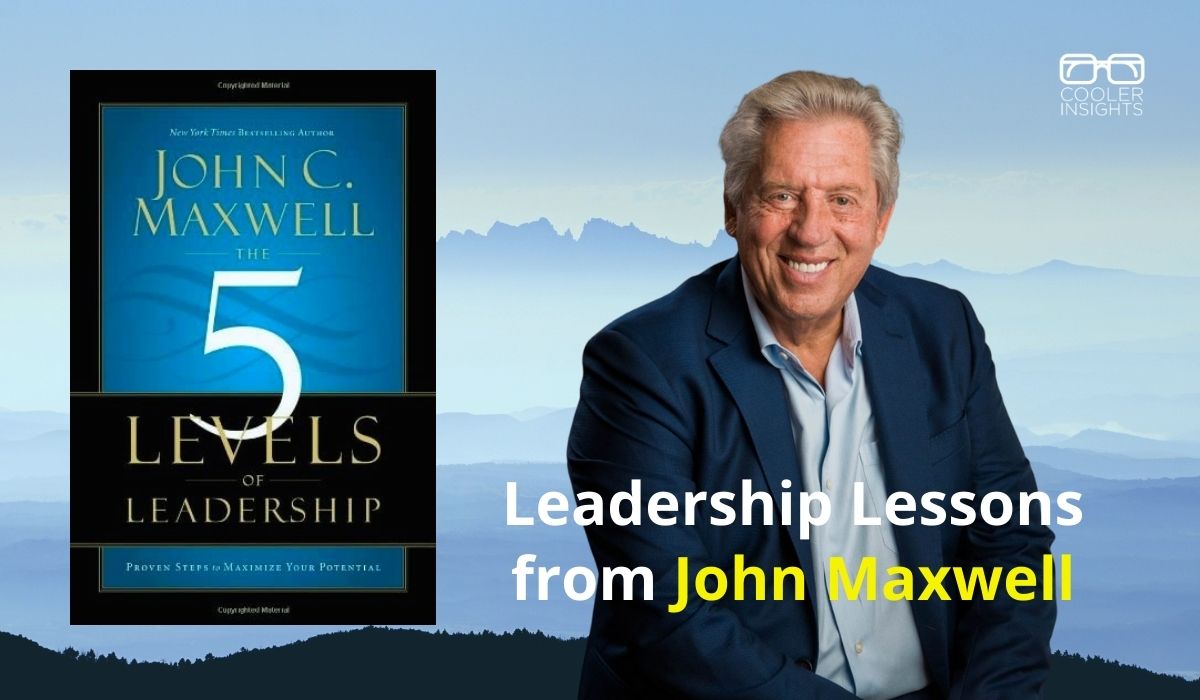
How are peak leaders developed? What differentiates a superstar CEO like Jack Welch from other less extraordinary leaders?
The answer, according to bestselling author John C. Maxwell , lies in The 5 Levels of Leadership .
Focused on growing one’s leadership potential in a tiered manner, the book provides pragmatic steps to scale the leadership ladder while achieving lasting impact on one’s organisation and followers.
Packed with examples from Maxwell’s own leadership journey as well as stories of legendary leaders like superstar coach John Wooden of UCLA and Southwest Airlines CEO Herb Kelleher, the book is chock full of quotable quotes and maxims.
Some of the more memorable ones include the following:
“Leading an organisation is as much about soul as it is about systems…” – Herb Kelleher
“Good people are found, not changed.” – Jim Rohn
“No matter where you are in your leadership journey, never forget that what got you to where you are won’t get you to the next level.” – John Maxwell
“Victory is much more meaningful when it comes not just from one person, but from the joint achievements of many. The euphoria is lasting when all participants lead with their hearts, winning not just for themselves but for one another.” – Howard Schultz
The 5 Ps of Leadership
At its core, The 5 Levels of Leadership revolves around 5 “Ps” stacked in ascending order of significance.
These are Position , Permission , Production , People Development , and Pinnacle .
They are graphically represented by the diagram below:

Level 1 — Position
The first level of Position is achieved when one gets a job with a leadership responsibility. People often get promoted into leadership based on their potential, and a leadership position allows one to take charge of others by sheer fact of their title.
People have to follow these leaders because they have the authority and right to lead them. Often, tier one leaders depend on their rank and rules to get things done. They tend to be more supervisory and directive, relying on SOPs to get things done by their subordinates.
Level 2 — Permission
As a leader gravitates towards a more collegial style of leadership, Permission comes into play. Here, leaders leverage on their relationships with others, relying on open communication, encouragement, trust, and effective inter-human relations to get things done.
As a permission-focused leader, you work with your team rather than through your team.
A key thing to remember here is the Golden Rule , ie
“Treat others as you want others to treat you.”
Level 3 — Production
Moving up to level 3, leaders start to harness Production as a key trait.
Focusing on results , such leaders demonstrate credibility by their ability to perform.
Leading by example and building powerful teams, they bring clarity to their roles, generate positive momentum, prioritise activities that generate high return, and act as change agents.
This stage is where teams can become highly productive and achieve great outcomes.
Level 4 — People Development
At the 4th level of People Development , leaders concentrate more of their energies on training, mentoring and coaching their followers to be leaders themselves.
Through reproduction , they can multiply their effectiveness. Here, leaders should recruit the best people possible, place them at the right positions, model leadership behaviours, equip others to do their jobs well, develop their life skills, empower them to succeed, and measure their effectiveness.
While training plays an important role in shaping the strengths, skills and competencies of your team, people development also involves mentoring and coaching your colleagues to rise to the occasion.
Level 4 — Pinnacle
Finally, Pinnacle leaders at level 5 epitomise the highest leadership accomplishment, ie the ability to develop other leaders to level 4. These legendary leaders gain a lot of respect by virtue of who they are and what they represent.
Making room for others at the top, level 5 leaders focus on finding successors, work on people’s strengths, give away power, and sees the potential of other leaders.
They create an inner circle to keep themselves grounded, continually develop other level 5 leaders and leave a lasting positive legacy.
22 Irrefutable Laws of Leadership
Beyond the 5 levels, Maxwell also cited frequently from his earlier book The 22 Irrefutable Laws of Leadership (you can get a good summary of the laws here ).
Some of these are somewhat obvious (eg The Law of Respect where people naturally follow leaders stronger than themselves) while others are more enlightening.
Personally, I found the Law of Buy-in – people buying into the leader, then the vision – especially illuminating. From my experience, it isn’t so much HOW the vision and goal is written as to WHO backs it which matters.
While I liked the neat framework provided by the book, I felt that breaking down each level into their upsides, downsides, best behaviours, laws of leadership, beliefs and guides was a little overwrought.
You do get a little lost ploughing through the hefty number of points in each section.
Overall, The 5 Levels of Leadership provides a useful reference to anybody keen to distil the essence of what truly effective leadership is all about. Its timeless lessons are useful in any age, and are embodied by the lives and examples of men and women who exemplify what sterling leadership was, is and will be.
Are you currently in a leadership position in your organisation? Which Level of Leadership do you think you’ll fall under?
Great summary. As a leadership trainer in Singapore, I noticed that Asians tend to stay at the lower levels of the leadership ladder. Do you think it is a cultural thing?
Nice Post. Gerard Associates also offers advice in QROPS Advice, QROPS Transfers, Guernsey, QROPS list and other QROPS Pension Advice. . I know something about this same information, to know you can click here
water softener water filter
This is an informative post review. I am so pleased to get this post article. I was looking forward to get such a post which is very helpful to us. Keep it up. . I know something information, to know you can click here Air Conditioning Brisbane Air Conditioning Installation Brisbane
Join The Discussion Cancel Reply
Your email address will not be published. Required fields are marked *
You may use these HTML tags and attributes: <a href="" title=""> <abbr title=""> <acronym title=""> <b> <blockquote cite=""> <cite> <code> <del datetime=""> <em> <i> <q cite=""> <s> <strike> <strong>
Save my name, email, and website in this browser for the next time I comment.
Lorem ipsum test link amet consectetur a
- Career Skills
- Change Management
- Communication Skills
- Decision Making
- Human Resources
- Interpersonal Skills
- Personal Development
- Program Management
- Project Management
- Team Management
- Learning Tracks
- Free Productivity Course
By Denis G.
The 5 Levels of Leadership: Book Summary
In this article:
The 5 Levels of Leadership was written by John C. Maxwell and helps you answer a couple of fundamental questions about leadership.
Namely, where are you as a leader right now, how do you get to the next level, and where should you ultimately aim to be as a leader?
Leadership isn’t a position you hold; it’s a journey and a process. Just because you have the word “manager” in your job title, you’re not automatically a great leader.
Leadership is about dealing with people, and the dynamics between those people, which means that the better you can influence people, the higher your leadership ability. The book provides a roadmap to get your leadership from where you are now to where you want to be.
Assessing The Current Situation
The book begins by encouraging you to determine which of the 5 Levels of Leadership you are currently at. It provides a four-step process to help you to do this.
- You assess your leadership.
- You assess each of your team members.
- Your team members assess you anonymously.
- Tally your results from the three assessments and see where you are.
You can assess yourself by following this link.
John C. Maxwell is a leadership expert, speaker, minister, and author who has sold over 20 million copies of his books worldwide.
In 2014 Inc. Magazine named him the #1 management and leadership expert worldwide.
The 5 Levels of Leadership
The 5 Levels of Leadership are shown in the following diagram.
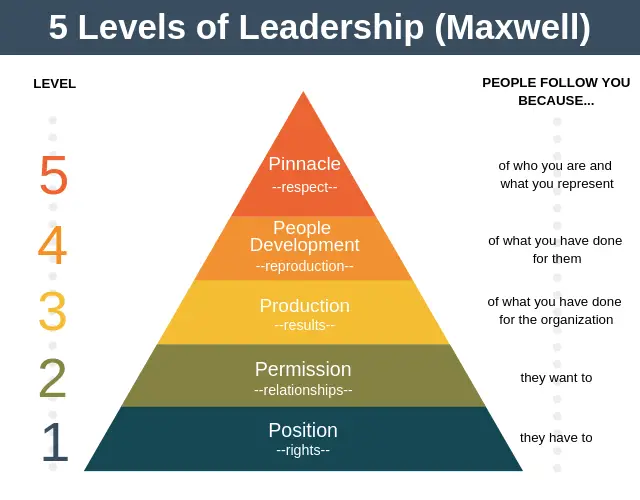
Here is a very brief overview of each of the 5 Levels of Leadership.
- Level 1: Position . People follow you because they have to.
- Level 2: Permission . People follow you because they want to.
- Level 3: Production . People follow you because of what you have done for the organization.
- Level 4: People Development . People follow you because of what you have done for them.
- Level 5: Pinnacle . People follow you because of who you are and what you represent. You get to this level when you develop new leaders that are themselves able to build leaders. The book estimates that less than 1% of leaders make it to this level.
Everyone starts their leadership journey at level one. The 5 Levels of Leadership provides a process to follow to grow as a leader, with the ultimate aim of making it to level five.
The 10 Insights
The book provides ten insights that can help you make more sense of the interplay between the levels.
- When you move up a level, you build on the previous level. You don’t leave it behind.
- Leadership is dynamic. You can work at a different leadership level from one team member to the next.
- The higher you go, the easier it becomes to lead.
- There is no shortcut to get to the next level. Each level requires more time and effort to reach it than the previous one.
- Although moving up a level takes a lot of time, moving down one or more levels can happen very quickly.
- The higher you go, the greater the returns.
- Moving to the next level always requires growth.
- Not getting to the next level not only limits you, but it also limits each of your team members.
- When you change position or organization, you rarely stay at the same level.
- You cannot climb the levels alone.
Let’s move on and examine each of the 5 Levels of Leadership in some more detail.
Level 1: Position
Position is the very first level of the 5 Levels of Leadership, and it represents the beginning of everyone’s leadership journey. Leadership at this level is granted because you receive a job title, but you haven’t yet built the influence to command respect from colleagues, either inside of or outside of your team.
While you have authority over your team, at level 1 you don’t wield any real influence over them so its hard to get the most out of them. Your team does what you tell them because they have to.
At level 1, you might be the boss, but you aren’t yet a leader. As such, it’s important not to see being given a management job title as your goal. Instead, try to see it as your starting point.
Upsides of Level 1
Some of the upsides of becoming a level 1 leader include:
- You’ve been given a leadership position because you deserve it, and this is something to celebrate.
- It allows you to think about what kind of leader you want to be, e.g. What’s your style? What are your values? You’re at the beginning of your leadership journey, so now is an excellent point to think about these things.
Downsides of Level 1
- Positional leaders don’t get the best out of their team; they probably get the minimum.
- Positional leadership can be misleading, i.e. just because you have a particular job title does not make you a leader.
- Position leaders can focus on politics and getting the next job title.
How to Make the Most of Your Position
- Don’t push people, help them and take an interest in them.
- Don’t expect your people to come to you, you must initiate things to earn their respect.
Laws of Leadership at the Position Level
- Lid: to unlock your effectiveness, you must commit to developing yourself as a leader.
- Process: Recognise that developing yourself as a leader is a lifelong process.
- Navigation: Recognise your limits. You might be able to steer the boat, but you’re not yet ready to chart the course.
To learn more about these laws, you will need to purchase the book, The 21 Irrefutable Laws of Leadership , also written by Maxwell.
Beliefs to Get to the Next Level
Before you can get to the next level, you must upgrade your beliefs:
- Your job title isn’t that important. It’s the work you do and how you help others.
- Your position is a tool you can use to help others, but people are your most valuable asset.
- A good leader doesn’t need to have the answer, they can work with others to find the answer.
- Good leaders include others.
Level 2: Permission
On this level of the 5 Levels of Leadership, your team follows you because they want to. You listen to your people and they, in return, listen to you.
Leaders on this level make people know that they matter. They make each member of their team feel important.
On this level, people want to work for you because they feel liked, valued, included, and trusted. Because of your strong relationships, people permit you to lead them.
As your relationships grow, so does trust, and the workplace becomes a more positive place. Lasting relationships create the foundation of Level 3.
In a nutshell, this level is all about relationships.
Upsides of Level 2
Some of the upsides of becoming a level 2 leader include:
- Work is more enjoyable when you get on with your team, and they get on with you.
- Spending time amongst people you like boosts everyone’s energy.
- Good relationships are formed when people value and respect each other.
- Two-way communication occurs at this level. You listen to your people, and they listen to you. This leads to better decision making.
Downsides of Level 2
- Being so focussed on relationships can make you seem weak as a leader.
- It can be frustrating to work in this way if your ambitious and just want to get things done.
- To be effective, you need to be open.
- You can leave yourself open to being taken advantage of.
How to Gain People’s Permission
- You must get to truly know yourself before you can openly get to know others.
- Develop a leadership style that is focused on people, rather than tasks.
- Treat others as you yourself want to be treated.
- Praise, along with words of encouragement are important. Be your team’s chief encourager.
- It is important to balance care for team members with candor.
Laws of Leadership at the Permission Level
- Influence: The true measure of your leadership is your influence.
- Addition: Add value by helping and serving others. Focus on people, not systems.
- Solid ground: Be trustworthy.
- Magnetism: Be the type of person you want to attract.
- Connection: Work on relating to people.
- Buy-in: Work to get people to buy-into (trust) you.
- Recognize that there is more to leadership than just influence; you have to take people somewhere.
- As well as growing closer, you must grow together.
- Sometimes it’s worth risking a relationship to achieve a vision as a team.
Level 3: Production
This level of the 5 Levels of Leadership is about delivering results. This level separates true leaders from leaders who simply hold a position.
There is more to being a leader than getting on with people. Great leaders get results. When followers see you achieving great results, it gives them a reason to follow you. When you deliver exceptional results, your leadership intensifies.
It’s on level 3 that influencing others can become fun. This is the first level where a leader can become a change agent: tackle thorny issues, big projects, and take their followers to the next level.
A history of achieving results combined with excellent relationships enables you to move your team towards the organization’s vision.
Upsides of Level 3
Some of the upsides of becoming a level 3 leader include:
- Your credibility increase when you deliver results.
- Your results set a standard for your followers, further increasing results.
- Delivering results builds momentum.
- People see your results and want to be part of your team.
Downsides of Level 3
- You can fall into the trap of thinking your a better leader than you are. You need to achieve results for your team as well as for yourself.
- There is a weight of responsibility associated with having to continually achieve results.
- Even though you are focused on results, you must not lose sight of your people. Level 2 is still important.
How to Make the Most of Production in Leadership
- Figure out where your strengths lie and focus on these areas.
- Communicate a clear vision. This will help with team productivity.
- Encourage your people to work together. This is the foundation of building a team.
- Focus on areas with the highest return, and never lose sight of the fact that results are your goal.
Laws of Leadership at the Production Level
- Respect: People will naturally want to follow leaders they see as stronger than themselves.
- Magnetism: Who you are is who you attract.
- Picture: People’s behavior mirrors what they see each day.
- Victory: Find a way for your team to win.
- Big Mo: Momentum is your new best friend.
- Priorities: Focus on results and not activities.
- Sacrifice: Let go of nonessentials.
- Buy-in: People will buy-in to you as a leader before they buy into your vision.
- Production isn’t enough. Think about how you can help people get to the next level in their lives and careers.
- Value, challenge and develop your followers.
- Growing leaders is the quickest way to achieve a vision.
- Developing your people gives you great fulfillment.
Level 4: People Development
At this level of the 5 Levels of Leadership, leaders change from focusing on delivering results to developing people. Leaders at this level reproduce themselves.
Leaders at this level reproduce and grow their influence as they transform followers into leaders in their own right. As the unique strengths of each new leader are unleashed, the entire organization rises to a higher level.
This level is all about reproduction.
Upsides of Level 4
Some of the upsides of becoming a level 4 leader include:
- At level 3, you focus on results, but at level 4, you deliver even better results by focusing on your people and empowering them to achieve.
- Only by growing people can success be sustained.
- If you grow others, it gives you the space to work on bigger things.
- It is hugely rewarding to see others develop.
Downsides of Level 4
- If you are insecure, you can feel threatened by the prospect of developing others.
- You must be willing to focus on the long-term. If you stay focused on the short-term, it can be hard to see the justification for developing your people.
How to Develop People
- Recruit only the best people you can.
- Place people into the right positions.
- Model to others the leadership behavior you expect from them.
- Coach others to live well and perform well.
- Empower others so they can succeed.
Laws of Leadership at the People Development Level
- Process: Leadership is a process; it doesn’t happen overnight.
- Addition: You add value when you serve others.
- Inner circle: Those in your inner circle determine your potential.
- Empowerment: Only a secure leader is willing to give power to others.
- Explosive growth: Developing new leaders is the only way to explosively grow the organization in a way you could never achieve on your own.
- Your biggest goal as a leader is to create more leaders.
- Believe in developing a leadership culture: teach, practice, coach, and reward leadership.
Level 5: Pinnacle
The highest level of the 5 Levels of Leadership is level 5. Maxwell argues that not many people make it to this level and those that do are naturally gifted.
Level 5 leaders develop their followers into level 4 leaders.
Developing leaders who can lead and not just follow is hard. It takes great skill, judgment, and commitment. But if you succeed, you will create a level 5 organization: an organization that is functioning at an extraordinarily high level.
Upsides of Level 5
Some of the upsides of becoming a level 5 leader include:
- It provides your leadership with reach. People will seek you out for advice.
- It creates a level 5 organization.
- You will create a legacy within the organization
Downsides of Level 5
- You can forget that there is always more to learn and more room to grow.
- You can start to believe your own press.
- You have to work hard to maintain focus on the vision.
How to Use the Pinnacle as a Platform to do Something Greater than Yourself
- Remain humble and open to learning.
- Create an inner circle to help keep you grounded.
- Create room at the top.
- Focus on what only you can do (your core strength).
- Plan your succession and your legacy.
- Respect: People naturally gravitate toward leaders who are stronger than themselves.
- Intuition: You will be able to see what courses of action lead to what outcomes.
- Timing: You will have learned how to take the right action at the right time.
- Legacy: You legacy will be measured by your successors.
5 Levels of Leadership Summary
Sometimes leadership books can read like a giant recipe, listing a multitude of things that you need to do and believe to consider yourself a great leader.
One of the things I really liked about this book is that it doesn’t do that. It helps you to figure out where you are right now as a leader and then gives you some advice to help you get to the next level, no matter what level you’re on right now.
In my opinion, it’s a good, detailed, and practical book which makes intuitive sense. However, it isn’t as far as I know backed up by research. Nevertheless, I’d still rate this book as a must-read for aspiring leaders and established leaders alike, and score it 9 out of 10.
To summarize the 5 Levels of Leadership, leadership is about growth in everything you do and everyone you interact with. It’s a lifelong, challenging journey that can be immensely rewarding. The book provides a practical roadmap of how to get from where you are as a leader currently to where you want to be. You just need the courage to embrace it.
Cite this article
Minute Tools Content Team, The 5 Levels of Leadership: Book Summary, Minute Tools, Sep, 2019 https://expertprogrammanagement.com/2019/09/maxwell-5-levels-of-leadership/
Originally hailing from Dublin, Denis has always been interested in all things business and started EPM in 2009. Before EPM, Denis held a leadership position at Nokia, owned a sports statistics business, and was a member of the PMI's (Project Management Institute’s) Global Executive Council for two years. Denis now spends his days helping others understand complex business topics.
How useful was this post?
Click on a star to rate it!
Average rating 0 / 5. Vote count: 0
No votes so far! Be the first to rate this post.
Related Tools
The six leadership styles by daniel goleman.
As a leader, the six leadership styles by Daniel Goleman provide you with a toolbox of leadership styles you can […]
Edgar Schein’s Organizational Culture Model
The culture model developed by Edgar Schein, sometimes called the cultural triangle, the three levels of culture model, or iceberg […]
Mintzberg’s Managerial Roles
Mintzberg’s Managerial Roles are a set of roles that managers undertake on a daily basis. As a manager, you wear […]
Trait Theory of Leadership
The Trait Theory of Leadership is a model that sets out to help identify future leaders. Trait theory is based […]
Transactional Leadership
Transactional leadership is a style of leadership that uses reward and punishment to motivate subordinates. Transactional leadership gets its name […]
Three Levels of Leadership Model
The Three Levels of Leadership Model is for practicing leaders who want to grow and be better at what they […]
Blake Mouton Managerial Grid
The Blake and Mouton Managerial Grid provides a simple way to understand your natural leadership style. It can also be […]
Bureaucratic Theory (Max Weber)
Max Weber’s Bureaucratic Theory of Management proposes that the best way to run an organization is to structure it into […]
Path-Goal Theory of Leadership
The Path-Goal Theory of Leadership is a model which proposes that a leader should change their leadership style depending on […]
Situational Leadership Model
The Situational Leadership Model, also known as Situational Leadership Theory, is a leadership model developed by Dr. Paul Hersey and […]

In our course you will learn how to:
This 5-week course will teach you everything you need to know to set up and then scale a small, part-time business that will be profitable regardless of what’s happening in the economy.
So if you’ve always wanted to be your own boss and have the flexibility and freedom that entails, then…
Do your future self a favor and check out our course designed to help you achieve exactly that.


The 5 Levels of Leadership: Proven Steps to Maximize Your Potential
About this ebook, ratings and reviews.
- Flag inappropriate
About the author
Rate this ebook, reading information, more by john c. maxwell.

Similar ebooks


- Business & Economics
- Analysis & Strategy

Download the free Kindle app and start reading Kindle books instantly on your smartphone, tablet or computer – no Kindle device required .
Read instantly on your browser with Kindle for Web.
Using your mobile phone camera, scan the code below and download the Kindle app.

Image Unavailable

- To view this video download Flash Player

Follow the author

The 5 Levels of Leadership: Proven Steps to Maximize Your Potential Paperback – 3 September 2013
10 days replacement, replacement instructions.

Purchase options and add-ons
- Print length 304 pages
- Language English
- Publisher Hachette Book Group USA
- Publication date 3 September 2013
- Dimensions 13.34 x 2.54 x 20.32 cm
- ISBN-10 1599953633
- ISBN-13 978-1599953632
- See all details
Frequently bought together

Customers who viewed this item also viewed

Product description
Book description, about the author, product details.
- Publisher : Hachette Book Group USA; Reprint edition (3 September 2013)
- Language : English
- Paperback : 304 pages
- ISBN-10 : 1599953633
- ISBN-13 : 978-1599953632
- Item Weight : 249 g
- Dimensions : 13.34 x 2.54 x 20.32 cm
- Country of Origin : USA
- #12,696 in Christianity (Books)
- #31,850 in Analysis & Strategy
- #47,459 in Personal Transformation
About the author
John c. maxwell.
John C. Maxwell is an internationally recognized leadership expert, speaker, coach, and author who has sold over 19 million books. Dr. Maxwell is the founder of EQUIP and the John Maxwell Company, organizations that have trained more than 5 million leaders worldwide. Every year he speaks to Fortune 500 companies, international government leaders, and organizations as diverse as the United States Military Academy at West Point, the National Football League, and the United Nations. A New York Times, Wall Street Journal, and Business Week best-selling author, Maxwell has written three books which have each sold more than one million copies: The 21 Irrefutable Laws of Leadership, Developing the Leader Within You, and The 21 Indispensable Qualities of a Leader. You can find him at JohnMaxwell.com and follow him at Twitter.com/JohnCMaxwell.
Customer reviews
- Sort reviews by Top reviews Most recent Top reviews
Top reviews from India
There was a problem filtering reviews right now. please try again later..
Top reviews from other countries
- Press Releases
- Amazon Science
- Sell on Amazon
- Sell under Amazon Accelerator
- Protect and Build Your Brand
- Amazon Global Selling
- Become an Affiliate
- Fulfilment by Amazon
- Advertise Your Products
- Amazon Pay on Merchants
- COVID-19 and Amazon
- Your Account
- Returns Centre
- 100% Purchase Protection
- Amazon App Download
- Conditions of Use & Sale
- Privacy Notice
- Interest-Based Ads

The 5 Levels of Leadership by John Maxwell | Summary
In whatever role you take on in life, “you are a leader.” But it is difficult to figure out how to take your leadership to the next level. Thus, leadership expert John Maxwell established the 5 Levels of Leadership paradigm in his book, Developing the Leader Within You .
The book in this summary, The 5 Levels of Leadership: Proven Steps to Maximize Your Potential , expands on the concept of the five levels from the John Maxwell leadership notes and offers the following benefits:
- Provides a clear understanding of Leadership so anyone can learn it.
- Defines Leading as a Verb, not a Noun as “Leadership is a process, not a position.”
- Breaks down Leading into action logic steps as it can be confusing and overwhelming.
- Gives a clear strategy for Leadership Development and building leadership skills in addition to the focus on career and entrepreneurial growth.
- Practice – “an action that may work in one situation but not necessarily in another”
- Principle – “an external truth that is as reliable as a physical law”
- Values – an embrace and internalization of a principle and internalizing
Buy The 5 Levels of Leadership on Amazon
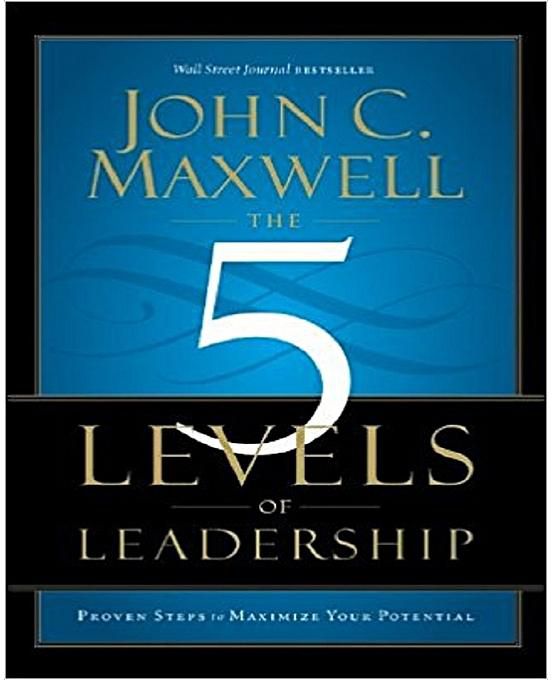
The 5 Levels of Leadership by John C. Maxwell
Proven Steps to Maximize Your Potential
Download the PDF Book Summary for The 5 Levels of Leadership by John C. Maxwell
Introduction.
The leadership definition is as follows:
Leadership – “Leadership is “the ability to obtain followers”
“If you think you are leading, and no one is following, you are only taking a walk.”
Overview of the 5 Levels of Leadership
There are 5 P’s of Leadership, which John Maxwell details below:
- Position (Rights) : People follow you because they have to.
- Permission (Relationships) : People follow you because they want to.
- Production (Results) : People follow you because of what you have done for the entire organization.
- People Development (Reproduction) : People follow because of what you have done for them.
- Pinnacle (Respect) : People follow you because of who you are and what you represent.
Insights into the 5 Levels of Leadership
- When you achieve a new level, you never leave the previous one behind.
- You are on different levels with every relationship, and your people respond accordingly.
- The higher your level, the easier it will become to lead.
- Also, the higher the level you achieve, the more personal resources of time and energy are required to achieve the next level.
- Going up levels occurs slowly, but dropping down can happen quickly.
- The higher the level achieved, the higher the returns on your leadership.
- Moving up the layers of leadership requires more and more growth.
- Not deliberately climbing the levels will limit your and your people’s effectiveness.
- Changing roles or organizations will typically change the level you are at.
- You cannot climb the stages of leadership by yourself.
Your interaction with your followers depends on:
- Where you are at with that follower,
- Where that follower perceives you to be as a leader, and
- Where that follower is in their leadership development.
Leadership Assessment
In the 5 Levels of Leadership, JohnMaxwell provides a four-part survey to provide in-depth insight and help you determine your level in leadership development:
- Leadership Level Characteristics: Applies to your leadership level in general.
- Individual Team Member Assessment: Evaluates your direct reports by you as the leader.
- Leadership Assessment: Evaluates you as the leader by your direct reports.
- Current Leadership Level Assessment: Provides a snapshot of your leadership.
Level 1: Position
“It’s a great place to visit, but you wouldn’t want to live there.”
In the 5 Levels of Leadership, John Maxwell describes the first level of position. A leader begins at position, which is the lowest level of leadership. As no ability or effort is required to achieve this level, it can be given to anyone based on appointment to a position or title. People will respond to this level simply because they have to.
However, you should not substitute position for having influence as you may be a manager but are not a leader. You must rely on rules and policies, as your subordinates do what is required and only respond to the bounds of your authority. Unfortunately, you will be unable to influence people and get no extra time or effort.
The Upside of Position
“You have been invited to the leadership table.”
There are four positive aspects as receiving a Leadership Position:
- Shows that one has leadership potential and is not due to politics, seniority, credentials, or convenience.
- Means some level of authority or power is recognized with the position and title.
- Bestows an invite to them to grow as a Leader.
- What are my values?
- What Leadership Practices and group norms do I want to implement?
The Downside of Position
“True leadership isn’t about position.”
There are eight negatives for the position as Positional Leaders:
- Have positions and tiles that are often misleading.
- Place a high value on it and tend to devalue their people.
- Feed on politics as they focus on control instead of contribution.
- Put rights over responsibilities by acting to make themselves look and feel important.
- Often get lonely if they misunderstand the functions and purpose of leadership.
- Become branded and stranded in their position and will get passed on opportunities.
- Experience high turnover as “people quit people, not companies.”
- Receive people’s least, not their best, with their people becoming either a clock watcher, a just-enough employee, or mentally absent.
Best Behaviors on Level 1
“How to make the most of your position:”
- Stop relying on position to push people and use other skills.
- Trade entitlement for movement as great leaders doesn’t take leadership for granted.
- Leave your position and initiate action to move toward your people.
The Laws of Leadership at the Position Level
- The Law of the Lid : Leadership ability determines a person’s level of effectiveness.
- The Law of Process : Leadership develops daily, not in a day.
- The Law of the Navigation : Anyone can steer the ship, but it takes a leader to chart the course.
Beliefs That Help a Leader Move Up to Level 2
- Titles are not enough as “a positional is not a worthy destination for any person’s life.
- People, not position, are a leader’s most valuable and appreciable asset.
- A leader doesn’t need to have all the answers but needs to attract those who fill in the knowledge gaps.
- A good leader sacrifices selfish personal ambition and always includes others.
Guide to Growing through Level 1
In the 5 Levels of Leadership, John C. Maxwell provides these guidelines to grow through Level 1:
- Thank the people who invited you into leadership
- Dedicate yourself to leadership growth
- Define your leadership
- Shift from position to potential
- Focus on the vision
- Shift from rules to relationships
- Initiate contact with your team members
- Don’t mention your title or position
- Learn to say, “I Don’t Know”
- Find a leadership coach
Download the PDF Book Summary for The 5 Levels of Leadership by John Maxwell
Level 2: permission.
“You can’t lead people until you like people.”
In John Maxwell’s 5 Levels of Leadership, he overviews the second level of permission. This level is based on relationships as people will follow you because they want to. You need to develop emotional intelligence and build relationships with your people by developing trust and getting to know them.
Therefore, good leaders need to build and maintain sound relationships to reach higher levels of leadership. Your followers need to know who you are, and you need to determine who your people are. John Maxwell states, “You can like people without leading them, but you cannot lead people well without liking them.”
The Upside of Permission
“The workplace has become more pleasant for everyone.”
There are five positives to focusing on permission and relationships as Leadership Permission:
- Makes work more enjoyable as “leaders shift their focus from me to we.”
- Improves the energy level as you are surrounded by great relationships that create a positive, energetic environment.
- Creates open channels of communication by replacing “top-down positional leadership with side-by-side relationships.
- Emphasizes the value of each person as to effectively lead beyond Level 1, you must care for your people.
- Leadership Permission nurtures trust to allow for your people safe to create, share, question, try, and take risks.
The Downside of Permission
“The pressure is on you to build positive relationships.”
There are five negatives to building positive relationships as Permission Leadership:
- Appears too soft for some people in a high-performance, leadership-intensive environment.
- Creates frustration for high achievers who want to get things done now instead of taking the time required to build strong relationships.
- Can be taken advantage of as relationship building can create closeness and kindness that be mistaken for weakness.
- Requires openness to be effective, which is tough as leadership leaders don’t want to admit their mistakes and show their weaknesses.
- Forces you to deal with the whole person as you must like your people and become more likable.
Best Behaviors on Level 2
“How to gain people’s permission:”
- Connect with yourself before trying to connect with others by practicing self-awareness, self-image, self-honesty, self-improvement, and self-responsibility.
- Develop a people-oriented leadership style by listening, learning , and leading while developing relationships along the way.
- Practice the Golden Rule: “Do unto others as you would have them do unto you.”
- Become the Chief Encourager of your team by encouraging them to work hard and strive for their best to meet your expectations.
- Create a balance between care and candor as care without candor creates dysfunctional relationships, while the opposite creates distant relationships.
The Laws of Leadership at the Permission Level
- The Law of Influence : The true measure of leadership is influence – nothing more, nothing less.
- The Law of Addition : Leaders add value by serving others.
- The Law of Solid Ground : Trust is the foundation of leadership.
- The Law of Magnetism : Who you are is whom you attract.
- The Law of Connection : Leaders touch a heart before they ask for a hand.
- The Law of Buy-In : People buy into the leader, then the vision.
Beliefs That Help a Leader Move Up to Level 3
- Relationships are not enough as you need to help your people realize their potential to perform.
- Building relationships requires both compatibility to grow toward each other and intentionality to grow with each other
- Achieving the vision requires building a strong team over the risk of losing a single relationship.
Guide to Growing through Level 2
In the 5 Levels of.Leadership, John Maxwell provides these guidelines to grow through Level 2:
- Ensure you have the right attitude toward people
- Connect with yourself
- Understand where you are coming from
- Express value for each person on your team
- Evaluate where you are with your team
- Accept the whole person as part of leading
- Make fun of a goal
- Give people your undivided attention
- Become your team’s encourager-in-chief
- Practice care and candor
Level 3: Production
“Making things happen separates real leaders from wannabes.”
In the 5 Levels of Leadership, John Maxwell discusses the third level of production. Production is all about gaining momentum, getting things done, and attaining both personal and corporate productivity . The effective leader achieves results as this level “qualifies and separates true leaders from people who merely occupy leadership positions.”
When you advance to Level 3, your influence and credentials take hold while you have worked to build an environment of achievement. Also, you become a change agent to solve tough issues and make difficult decisions. And so, your people become more effective, take action, and achieve results on your behalf. As a result, great things happen as “work gets done, morale improves, profits go up, turnover goes down, and goals are achieved.”
The Upside of Production
“You now have leadership credibility.”
There are six positives to Level 3 as Leadership Production:
- Provides credibility to the leader as your people will welcome you achieving results.
- Models and sets the standard for others visually when you lead by example.
- Provides clarity and reality to the vision as your team will take action and see progress toward the vision.
- Solves many issues as effective leaders remove obstacles, extinguish fires, and correct mistakes.
- Establishes momentum by making things happen and producing results.
- Sets the foundation for team-building to assemble a winning team in the entire organization.
The Downside of Production
“The weight of leadership just got heavier.”
There are four negatives to Level 3 as a Productive Leader:
- May believe that they are a successful leader, but personal success does not always translate into team success.
- Feels a heavy burden of responsibility for results and can get tired of leading.
- Needs to make difficult decisions regarding production that makes leading difficult.
- Demands continual focus on Level 2 as there is a temptation to neglect relationships.
Best Behaviors on Level 3
“How to make the most of production in leadership:”
- Understand how your personal gifts and abilities contribute to the organizational vision.
- Cast vision for what needs to be accomplished by helping people define success, commit to the vision, and help them experience success.
- Develop your people into a high-productivity team by choosing complementary people, providing feedback, and fostering a positive environment.
- Prioritize the resources that yield high returns while eliminating the unnecessary stuff using the 80/20 Rule .
- Be a change agent to building momentum by finding common ground in vision, values, relationships, attitude, and communication.
- Remain focused that your main goal is attaining results regardless of the issues and obstacles.

The Laws of Leadership at the Production Level
- The Law of Respect : People naturally follow leaders stronger than themselves.
- The Law of the Picture : People do what people see.
- The Law of Victory : Leaders find a way for the team to win.
- The Law of Big Mo : Momentum is a leader’s best friend.
- The Law of Priorities : Leaders understand that activity is not necessarily accomplishment.
- The Law of Sacrifice : A leader must give up to go up.
Beliefs That Help a Leader Move Up to Level 4
- Production is not enough, as you need to develop your people in a leadership culture.
- People are your own organization’s most appreciable asset, so prioritize their growth more a much brighter future.
- Growing leaders is the most effective way to accomplish the vision and contribute to the leadership team.
- People development is the greatest fulfillment for a leader, so help yourself first to better help others.
Guide to Growing through Level 3
In the 5 Levels of Leadership, John Maxwell provides these guidelines to through Level 3:
- Be the team member you want on your team
- Translate personal productivity into leadership
- Understand everyone’s productivity strengths
- Cast vision continuously
- Build your team
- Use momentum to solve problems
- Discern how team members affect momentum
- Practice the Pareto Principle or the 80/20 Rule
- Accept your roles as the change agent
- Don’t neglect Level 2
Level 4: People Development
“Helping individual leaders grow extends your influence and impact.”
“Leaders become great, not because of their power, but because of their ability to empower others.” In The 5 Levels of Leadership, John Maxwell describes the fourth level of people development. Developing a new leader involves taking a follower and helping them use their position, relationships, and productivity to reach higher levels of leadership. As a result, you empower others and reproduce yourself.
Therefore, you need to cultivate leadership ability in your people to reach higher levels of leadership. Level 4 requires both a high degree of the following:
- Teamwork rises to peak levels as the team produce because of the depth and loyalty of relationships.
- Performance improves because more leaders in your team create elite organizations and collectively lift everybody’s performance.
As a leader in Level 4, you change the lives of the people you lead, and the relationships work in your favor.
The Upside of People Development
“The potential of the organization just got greater.”
There are several positives to developing your people as it:
- Differentiates you from most leaders by prioritizing the growth of your people over increasing productivity .
- Ensures that growth is sustainable by delegating responsibility and trusting your people to execute their work.
- Empowers others to fulfill their leadership responsibilities so everyone shares responsibility and wins collectively.
- Empowers the leader to lead at a higher level as it frees up time for thinking, envisioning, and strategizing.
- Provides great personal fulfillment from getting the best out of your people.
The Downside of People Development
“Leading in Level 4 requires high levels of maturity and skill.”
There are four negatives to developing your people:
- Selfishness causes leaders to not attain maturity and neglect developing their people.
- Insecurity can make leaders feel threatened by developing people as it conflicts with their ego, cedes control, and creates mistrust.
- Shortsightedness causes leaders to restrict the potential of themselves, their people, and their entire organization.
- Lack of commitment prevents leaders from developing their people as it requires a high-level of security and skill.
Best Behaviors on Level 4
“How to develop people:”
- Recruiting : Find the best people possible by examining their chemistry, character, capacity, and contribution.
- Positioning : Assign the right people to the right position to build a smart team .
- Modeling : Show others how to lead in their leadership journey.
- Equipping : Help others succeed in their role by the process of gaining competence, demonstrating, coaching, empowering, and reproducing.
- Developing : Teach them to also succeed in life through assessment, challenge, and support.
- Empowering : Enable people to succeed by holding them accountable to their goals .
- Measuring: Evaluate your people to maximize their efforts and perform at high levels.
The Laws of Leadership at the People Development Level
- The Law of Process : Leadership develops daily as a habit , not in a day.
- The Law of the Inner Circle : A leader’s potential is determined by those closest to him.
- The Law of Empowerment : Only secure leaders give power to others.
- The Law of Explosive Growth : To add growth, lead followers – to multiply, lead leaders.
Beliefs That Help a Leader Move Up to Level 5
- The primary goal of leadership is to develop leaders and improve lives, not gain followers, or get stuff done.
- As a leader, you must create a culture that creates a positive difference and develops new leaders.
- Producing leaders is not only a job commitment but also a life commitment.
Guide to Growing through Level 4
In the 5 Levels of Leadership, John Maxwell provides these guidelines to grow through Level 4:
- Be willing to keep growing yourself
- Decide that people are worth the effort
- Work through your insecurities
- Recruit the best people you can develop
- Commit to spending the time needed to develop leaders
- Create a personal development process that must occur daily, be measurable, include things you value, and be aligned to your strengths
- Never work alone
- Blend the soft and hard sides of development
- Take responsibility for energizing others
- Remain approachable as a leader, role model, and coach
Level 5: The Pinnacle
“The highest leadership accomplishment is developing other leaders to Level 4.”
In the 5 Levels of Leadership, leadership expert John Maxwell discusses the fifth level of pinnacle leaders. Good leaders employ effort, skill, and intentionality, as many great challenges, to go from Level 1 to 4 in their leadership journey. But to achieve all 5 levels of leadership, pinnacle leaders need to have natural leadership ability in their own right.
The key to reach all 5 levels of leadership is developing leaders to become Level 4 leaders. It is very difficult to get your followers to lead but doing so will improve your organization significantly. Consequently, you create new opportunities, build a huge degree of influence, and establish a legacy, which transcends your position, your organization, and you’re your industry.
The Upside of the Pinnacle
“Your influence has expanded beyond your reach and your time.”
There are three benefits to reaching the pinnacle:
- Creates a Level 5 or elite-level organization that possesses transformational leaders that operate at the highest levels of leadership.
- Establishes a legacy within the organization that reaches beyond your tenure and possibly lifetime.
- Provides an extended platform for leading other leaders beyond their team and organization.
The Downside of the Pinnacle
“You may start to believe it’s all about you.”
Conversely, there are three drawbacks to achieving the pinnacle:
- Makes feel comfortable think that you have arrived at the destination.
- Causes you to believe your own press and take yourself way too seriously.
- Can make you lose focus, so do not lose sign of where you are.
Best Behaviors on Level 5
“How to use the pinnacle as a platform to do something greater than yourself:”
- Create space for other leaders at the top of the levels of leadership.
- Provide consistent mentorship to all potential Level 5 leaders, so you can later promote the best leaders.
- Construct an inner circle to keep you grounded and push your own limits as a leader.
- Serve the organization in a way that only Level 5 leaders with your influence that can be leveraged to add value to others.
- Plan for the future Level 5 leaders that will succeed your leadership will end one day.
- Leave a positive, lasting legacy that will impact the leaders to come in the future.
The Laws of Leadership at the Pinnacle Level
- The Law of Intuition : Evaluate everything with a leadership bias.
- The Law of Timing : When to lead is as important as what to do and where to go.
- The Law of Legacy : A leader’s lasting value is measured by succession.
- The Law of Explosive Growth : To add growth, lead followers; to multiply growth, lead leaders.
Help Others Move Up to Levels 4 and 5
“Create crucible moments for the leaders you develop:”
- Identify essential leadership qualities and create vital leadership lessons to teach.
- Seek unforeseen or unconventional key moments that leaders can learn from.
- Implement your own critical moments as guidelines to teach others.
- Introduce your leaders to other leaders in your organization that will help them.
Guide to Being Your Best at Level 5
In the 5 Levels of Leadership, pinnacle leaders stand for the following guidelines in Level 5:
- Remain humble and teachable
- Maintain your core focus
- Create the right inner circle to keep you grounded
- Do what only you can do
- Create a supercharged leadership development environment
- Create room at the top
- Develop your top leaders and form strategic alliances with them
- Plan your succession
- Plan your legacy
- Use your leadership success as a platform for something greater
Next Steps: Buy the 5 Levels of leadership
The 5 Levels of Leadership: Proven Steps to Maximize Your Potential is one of my favorite John Maxwell books as it’s an insightful book that helps readers gain a better understanding of what it takes to become a powerful leader. The five levels of Position, Permission, Production, People Development, and Pinnacle provide a great framework for those seeking leadership development.
Whether you are new to developing your leadership skills or want to take your skills to the next level, this book is for you. Maxwell has mastered the art of presenting complex leadership concepts in an easy-to-read manner, making his writing a great read for growth-oriented people around the world.
If you are an aspiring leader, get yourself a copy of 5 Levels of Leadership today and start developing your potential as a leader!
Dev is a strategist, productivity junkie, and the founder of the Process Hacker !
I will help you scale and profit by streamlining and optimizing your operations and project management through simple, proven, and practical tools.
To get help for your business, check out my blog or book a call here !
Similar Posts

How to Overcome Mental Blocks
In this blog post, we will discuss tips and tricks for how to overcome mental blocks and break down the barriers that are holding you back. We will also talk about how to stay motivated when things get tough.

Traveling Mailbox Review: Best Virtual Mailbox?
Discover in our Traveling Mailbox review if this remote mailbox service can simplify mail management for you while you on on the road!

What is a Fractional CRO? Why Hire One?
Explore how a Fractional CRO boosts sales & revenue, driving cost-effective growth with new revenue streams & team alignment for success.

Communicate Ideas Effectively in Three Steps
There are three easy steps that will help you communicate ideas effectively and briefly before you dive into more detail.

Essentialism by Greg McKeown | Book Summary
In Essentialism, Greg McKeown teaches you how to be an Essentialist. You can discern what is essential, eliminate everything that is trivial, and execute on contributing to what matters the most to you.

Profit Wise by Jeff Morrill | Book Summary
In his book, Profit Wise, Jeff Morrill shows you how to make more money in the long-run and enjoy the journey by doing the right thing.

- Religion & Spirituality
- Christian Books & Bibles

Recommended Retail Price (RRP)

Download the free Kindle app and start reading Kindle books instantly on your smartphone, tablet or computer— no Kindle device required .
Read instantly on your browser with Kindle for Web.
Using your mobile phone camera, scan the code below and download the Kindle app.

Image Unavailable

- To view this video download Flash Player

Follow the author

The 5 Levels of Leadership: Proven Steps to Maximize Your Potential Paperback – 3 September 2013
Purchase options and add-ons.
- Print length 304 pages
- Language English
- Publisher Center Street
- Publication date 3 September 2013
- Dimensions 13.34 x 2.54 x 20.32 cm
- ISBN-10 1599953633
- ISBN-13 978-1599953632
- See all details
Frequently bought together
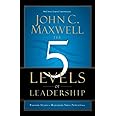
Customers who viewed this item also viewed
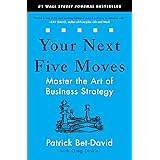
Product description
From the publisher, about the author, product details.
- Publisher : Center Street; 1st edition (3 September 2013)
- Language : English
- Paperback : 304 pages
- ISBN-10 : 1599953633
- ISBN-13 : 978-1599953632
- Dimensions : 13.34 x 2.54 x 20.32 cm
- 87 in Journal Writing
- 118 in Christian Self Help
- 254 in Essays & Correspondence
About the author
John c. maxwell.
John C. Maxwell is an internationally recognized leadership expert, speaker, coach, and author who has sold over 19 million books. Dr. Maxwell is the founder of EQUIP and the John Maxwell Company, organizations that have trained more than 5 million leaders worldwide. Every year he speaks to Fortune 500 companies, international government leaders, and organizations as diverse as the United States Military Academy at West Point, the National Football League, and the United Nations. A New York Times, Wall Street Journal, and Business Week best-selling author, Maxwell has written three books which have each sold more than one million copies: The 21 Irrefutable Laws of Leadership, Developing the Leader Within You, and The 21 Indispensable Qualities of a Leader. You can find him at JohnMaxwell.com and follow him at Twitter.com/JohnCMaxwell.
Customer reviews
Review this product.
- Sort reviews by Top reviews Most recent Top reviews
Top reviews from Australia
There was a problem filtering reviews right now. please try again later..
Top reviews from other countries
- Corporate Information
- Press Releases
- Amazon Science
- Protect and build your brand
- Independently Publish with Us
- Sell on Amazon
- Drive with Amazon Flex
- Advertise Your Products
- Associates Program
- Host an Amazon Hub
- COVID-19 and Amazon
- Your Account
- Your Orders
- Delivery Rates & Policies
- Returns & Replacements
- Manage Your Content and Devices
- Recalls and Product Safety Alerts
- Conditions of Use & Sale
- Privacy Notice
- Interest-Based Ads Notice
The 5 Levels of Leadership
A business executive. A softball coach. A classroom teacher. A volunteer coordinator. A parent.
Whether you’re one of these things or all of these things, one thing remains true:
You are a leader .
But where are you on your leadership journey, and where do you go from here? Over my years of teaching about leadership, that question exists at the heart of so many leaders. Everyone wants to know where they stand and how to get to the next level. And you are probably no different!
That’s why I developed the 5 Levels of Leadership paradigm in my book, Developing the Leader Within You, and then expanded it in my book, The 5 Levels of Leadership. I wanted to help leaders understand and increase their effectiveness. And while there is more to this teaching than space in this blog, today I want to offer a general overview of the 5 Levels as a reminder that you are still on your way as a leader – and so am I! So feel free to bookmark this page or print it out as a quick guide for your journey as a leader.
THE 5 LEVELS OF LEADERSHIP
Level 1 — position.
The lowest level of leadership—the entry level, if you will—is Position. It’s the only level that requires no ability or effort to achieve. After all, anyone can be appointed to a position! While nothing is wrong with having a leadership position, everything is wrong with relying only on that position to get people to follow. That’s because it only works if you have leverage (such as job security or a paycheck) over your followers. At Level 1, people only follow if they believe that they have to.
People who remain on the position level may find it difficult to work with volunteers. Why? Because position does not automatically result in influence, and volunteers are aware that they don’t have to follow anyone. They truly only follow if they want to.
But the news is not all bad about this level. It is a prime place for you to begin investing in your growth and potential as a leader. Use your time at this level learning to lead yourself – through priorities and self-discipline – and you’ll be ready to move to the next level.
Level 2 — Permission
Level 2 is based on relationship . At this level, people choose to follow because they want to. In other words, they give the leader Permission to lead them. To grow at this level, leaders work on getting to know their people and connecting with them. You can’t lead without people, which means you need to learn to like people if you want to lead well!
When you like people and treat them as individuals who have value, you begin to develop positive influence with them. Trust grows, which usually leads to respect. And the environment becomes much more positive—whether at home, on the job, at play, or while volunteering. Level 2 is where solid, lasting relationships are built that create the foundation for the next level.
Level 3 — Production
The best leaders know how to motivate their people to GTD – get things done ! And getting things done is what Level 3 is all about. On this level, leaders who produce results build their influence and credibility. People still follow because they want to, but they do it because of more than the relationship. People follow Level 3 leaders because of their track record.
The Production level is where leaders can become change agents. Work gets done, morale improves, profits go up, turnover goes down, and goals are achieved. The more you produce, the more you’re able to tackle tough problems and face thorny issues. Leading and influencing others becomes fun, because when everyone is moving forward together, the team rises to another level of effectiveness.
It’s important to note here that the goal with the 5 Levels is not to move away from one level to grow at a new level. Instead, these 5 levels of leadership build upon each other. In other words, Level 3 leaders still need to do the things that make Level 2 happen. They just add Level 3 strategies to the mix. And as they become effective at Level 3, they are ready to layer on the goals of the next levels.
Level 4 — People Development
Level 4 can be summed up in one word: reproduction . Your goal at this level is to identify and develop as many leaders as you can by investing in them and helping them grow.
The reason is simple: When there are more leaders, more of the organization’s mission can be accomplished. The people you choose to develop may show great potential for leadership, or they may be diamonds in the rough, but the main idea is the same: When you invest in them, you can reproduce yourself.
The more you raise up new leaders, the more you will change the lives of all members of the team. As a result, people will follow you because of what you’ve done for them personally. And as an added bonus, some of those mentoring relationships are likely to last a lifetime.
So to grow at the people development level, you need to make investing in leaders a priority, and take intentional steps every day to help them grow. Do that consistently, for long enough, and you may begin to reap the rewards of the next level.
Level 5 — Pinnacle
The highest level of leadership is also the most challenging to attain. It requires longevity as well as intentionality. You simply can’t reach Level 5 unless you are willing to invest your life into the lives of others for the long haul. But if you stick with it, if you continually focus on both growing yourself at every level, and developing leaders who are willing and able to develop other leaders, you may find yourself at the Pinnacle.
The commitment to becoming a Pinnacle leader is sizeable, but so are the payoffs. Level 5 leaders develop Level 5 organizations. They create opportunities other leaders don’t. They create a legacy in what they do. People follow them because of who they are and what they represent. In other words, their leadership gains a positive reputation . As a result, Level 5 leaders often transcend their position, their organization, and sometimes their industry.
There’s so much more I’d love to tell you, but let me leave you with this. Leadership is about growth – for yourself, your relationships, your productivity, and your people. To lead well, you must embrace your need for continual improvement, and the 5 Levels provide a leadership GPS to help you with your journey. You must know where you are, to know where you’re going.
Otherwise, as the Cheshire Cat told Alice, when you don’t know where you’re going, any road will get you there.
For more in-depth teaching on The 5 Levels of Leadership, read my 2011 book on the subject. Or learn from one of my expert facilitators at a workshop in your area.
36 Comments
[…] John Maxwell’s Blog Post The Five Levels Of Leadership […]
What if you do the assessment and there is a tie for two (2) levels, which one do you choose and why?
Is this site still active? No one is responding
Hi Racquel–thank you for your persistence and patience. I just replied to your much earlier comment, and would love to help you further should you need it.
Gerroe–great question, and thanks for being patient waiting for an answer! The simplest answer is whichever level comes first within the five. For example, if the two levels that are tied are 2 and 3, focus on Level 2 because you must be good there first. If you have additional questions, feel free to tag me in your comments–my name is Jason Brooks and I’m happy to help you!
For the team members point of view, I decided the number of team members who placed me on a particular leadership level based on the number of team members who answered “yes” to all the questions in that level? For example, I have 5 team members, all of them said “yes” to level 1 questions but 3 answered “no” to Level 2 so I said 5 persons placed me at level 1 but 2 at Level 2. Is that an appropriate strategy?
Hi Racquel–thanks for being BEYOND patient. Nearly a year is a long time to wait for an answer, so I apologize for the delay. You are correct in how you assessed the responses from your team members. You can continue using the same logic for the remainder of the survey answers. If you have any further questions, feel free to call me out by name in your comments–it’s Jason Brooks, and I am delighted to help you.
[…] this is the main thrust of many leadership models. In John Maxwell’s “5 Levels of Leadership” model someone may be assigned a leadership position, but they still have to earn permission (engagement) […]
[…] is what do you have to do to build credibility as their leader? The answer is in understanding the 5 levels of leadership. Most importantly, working your way from being a Level 1, a position leader, to a Level 2, a […]
Highly appreciated. having watched the youtube and read the tips, I am standing at a wow position. At least I know that position is not an end to itself but a step in the leadership ladder. This has made me to aspire more if I want to see that people want to follow me and not that it’s me that demands from them to follow me. This is very helpful. Thank you and kind regards.
[…] Source : https://www.johnmaxwell.com/blog/the-5-levels-of-leadership1/ […]
VEry informative . I dont know though how I can apply in church settings.
[…] John Maxwell tells us that there are five levels of leadership. […]
[…] I will encourage you to read more about John C Maxwell’s 5 levels of leadership: https://www.johnmaxwell.com/blog/the-5-levels-of-leadership1/ […]
[…] Maxwell has effectively expounded the idea of leadership levels. His five levels of leadership start with a personal leadership – Position as level 1. Afterward, level 2 to 5 mainly […]
[…] as a leader is much the same way. John C. Maxwell’s 5 Levels of Leadership framework provides a concrete explanation of your evolution on your way to becoming a masterful […]
[…] John is a leadership expert; he developed the 5 levels of leadership framework and is a best selling author. You should check out his work here. […]
Have a good day.
I love 5 levels of leadership framework. I inspire by this methodology.
I’ve written a leadership insight article inspired by John C. Maxwell.
You can read my blog.
https://forbesarticles.com/leadership-insights/
Zohaib Butt Success Coach and Corporate Trainer
[…] J. (2016) ‘ The 5 Levels of Leadership’ [online] available from < https://www.johnmaxwell.com/blog/the-5-levels-of-leadership1/> ; [25 June […]
Very encouraging and exiting lesson from the 5 levels of leadership and it is easier to solve strategic leading challenges. I am overwhelmed.
[…] Maxwell’s 5 niveaus van leiderschapdefinieert een cumulatieve reeks kwaliteiten voor groei als leider, en Budd stelt voor om zich te […]
[…] Maxwell’s 5 Levels of Leadershipdefines a cumulative set of qualities for growth as a leader, and Budd suggests focusing on […]
[…] Search For MeaningThe John Maxwell Leadership ScaleThe Motive by Patrick LencioniThe Serenity PrayerMichael’s Free Ebook: Stop Thinking Like an […]
[…] his book, The 5 Levels of Leadership – John Maxwell talks about this anxiety, the concept is, when a leader gets to an important position she […]
[…] talked and written at lengths on John Maxwell’s 5 Levels of Leadership as (one of my favourites) the foundation for all leadership development. It can serve both as an […]
[…] all about relationship, relationship, relationship. (I’ve heard this for so many years in the Christian leadership context from John Maxwell. I’ve also explored the concept of trust in other posts, here and […]
[…] John Maxwell […]
I’d be excited to follow updates on this blog or related posts. Thank you very much, sir.
[…] facet of seniority and something to be achieved (and enjoyed) – what John Maxwell referred to as ‘Level 1 leadership’ – resulting in organisations that primarily ‘looked upwards’. The dominant leadership […]
[…] jednej ze swoich najsłynniejszych, a jednocześnie najbardziej praktycznych książek „5 levels of leadership” John Maxwell przybliża model przywództwa opracowany na bazie swoich doświadczeń oraz […]
I will go for the second (2) level because without the permission of the people you want to lead you can’t lead them, and even if you force them, if they have any chance to kill you they will because they did not give you the permission to do so. THANK YOU.
[…] that truly listen to the people they lead before making decisions. I would suggest checking the The 5 Levels of Leadership by John Maxwell as inspirational material for improving your leadership […]
[…] C. Maxwell has described in his book “The 5 Levels of Leadership” the different phases that occur in the path of becoming an inspiring […]
[…] The 5 Levels of Leadership […]
[…] C. Maxwell’s fourth Level of Leadership focuses on people’s development. This is a crucial point that separates leaders from […]
[…] When you show your people that you care for them, support their growth and trust them, they will eventually work for you because they want to, not just because they have to. They will work for you because of what you have done for the organization and for them and ultimately because of who you are and what you represent (John Maxwell: The 5 levels of leadership). […]
Leave a Comment Cancel Reply
Notify me of follow-up comments by email.
Notify me of new posts by email.
This site uses Akismet to reduce spam. Learn how your comment data is processed .
Reserve el libro en Amazon

- Guidelines For Guest Post Submissions
- Affiliate Partners

- Books & Reviews
[Review] The 5 Levels Of Leadership

How are peak leaders developed? What differentiates a superstar CEO like Jack Welch from other less extraordinary leaders?
The answer, according to bestselling author John C. Maxwell , lies in “ The 5 Levels of Leadership “. Focused on growing one’s leadership potential in a tiered manner, the book provides pragmatic steps to scale the leadership ladder while achieving lasting impact on one’s organisation and followers.
Packed with examples from Maxwell’s own leadership journey as well as stories of legendary leaders like superstar coach John Wooden of UCLA and Southwest Airlines CEO Herb Kelleher, the book is chock full of quotable quotes and maxims. Some of the more memorable ones include the following:
“Leading an organisation is as much about soul as it is about systems…” – Herb Kelleher
“Good people are found, not changed.” – Jim Rohn
“No matter where you are in your leadership journey, never forget that what got you to where you are won’t get you to the next level.” – John Maxwell
“Victory is much more meaningful when it comes not just from one person, but from the joint achievements of many. The euphoria is lasting when all participants lead with their hearts, winning not just for themselves but for one another.” – Howard Schultz
At its core, The 5 Levels of Leadership revolves around 5 “Ps” stacked in ascending order of significance. These are Position , Permission , Production , People Development , and Pinnacle . They are graphically represented by the diagram below:

The first level of Position is achieved when one gets a job with a leadership responsibility. People often get promoted into leadership based on their potential, and a leadership position allows one to take charge of others by sheer fact of their title. People have to follow these leaders because they have the authority and right to lead them. Often, tier one leaders depend on their rank and rules to get things done.
As a leader gravitates towards a more collegial style of leadership, Permission comes into play. Here, leaders leverage on their relationships with others, relying on open communication, encouragement, trust, and effective inter-human relations to get things done.
A key thing to remember here is the Golden Rule , ie “Treat others as you want others to treat you.”
Moving up to level 3, leaders start to harness Production as a key trait. Focusing on results , such leaders demonstrate credibility by their ability to perform. Leading by example and building powerful teams, they bring clarity to their roles, generate positive momentum, prioritize activities that generate high return, and act as change agents.
At the 4th level of People Development , leaders concentrate more of their energies on training, mentoring and coaching their followers to be leaders themselves. Through reproduction , they can multiply their effectiveness. Here, leaders should recruit the best people possible, place them at the right positions, model leadership behaviours, equip others to do their jobs well, develop their life skills, empower them to succeed, and measure their effectiveness.
Finally, Pinnacle leaders at level 5 epitomise the highest leadership accomplishment, ie the ability to develop other leaders to level 4. These legendary leaders gain a lot of respect by virtue of who they are and what they represent.
Making room for others at the top, level 5 leaders focus on finding successors, work on people’s strengths, give away power, and sees the potential of other leaders. They create an inner circle to keep themselves grounded, continually develop other level 5 leaders and leave a lasting positive legacy.
Beyond the 5 levels, Maxwell also cited frequently from his earlier book “ The 21 Irrefutable Laws of Leadership ” (you can get a good summary of the laws here ). Some of these are somewhat obvious (eg The Law of Respect where people naturally follow leaders stronger than themselves) while others are more enlightening.
Personally, I found the Law of Buy-in – people buying into the leader, then the vision – especially illuminating. From my experience, it isn’t so much HOW the vision and goal is written as to WHO backs it which matters.
While I liked the neat framework provided by the book, I felt that breaking down each level into their upsides, downsides, best behaviours, laws of leadership, beliefs and guides was a little overwrought. You do get a little lost ploughing through the hefty number of points in each section.
Overall, “ The 5 Levels of Leadership ” provides a useful reference to anybody keen to distil the essence of what truly effective leadership is all about. Its timeless lessons are useful in any age, and are embodied by the lives and examples of men and women who exemplify what sterling leadership was, is and will be.
No related posts.
RELATED ARTICLES MORE FROM AUTHOR
[Review] Truebill, An Expense Tracking App
MyMonero Wallet – Review And Complete Guide
[Review] CPL One Online Advertising Platform
Recent articles.
Following The Herd Isn’t A Smart Investment Strategy – Here’s 3...
Teamwork In Law Practice: Unleashing The Power Of Attorney Teamwork For...
The Art Of Trespass: Building Bridges In Personal And Professional Relationships

The 5 Levels Of Leadership Summary
1-Sentence-Summary: The 5 Levels Of Leadership will teach you how to lead others with lasting influence by focusing on your people instead of your position.
Favorite quote from the author:

Audio Summary
Listen to the audio of this summary with a free reading.fm account*:
Have you ever had someone tell you that you are a natural leader? When I was younger I would hear people say this to me and wondered what they were talking about. Leadership seemed like a confusing thing that required more confidence than I had.
But over the years, and through John C. Maxwell ’s The 5 Levels of Leadership: Proven Steps to Maximize Your Potential , I’ve learned the deeper truths about what makes a great leader. Maxwell’s five levels, or ladders, that a great leader must climb are:
- People Development
These steps will teach you how to go from the kind of manager your employees dread being around, to one that has an affect on their entire career and lives.
Here are 3 of the greatest leadership lessons I’ve learned from this book:
- Your management position means nothing to those you lead when compared to the power of your personality and values.
- Developing relationships of trust is one of the most important things you can do to have a long-term impact for good.
- To make the biggest difference in your company and the lives of your people, you must train others to be leaders themselves.
Are you as excited as I am to learn the keys to motivational leadership? Let’s get started!
If you want to save this summary for later, download the free PDF and read it whenever you want.
Lesson 1: Use your personality and values to lead, not your management title.
Have you ever had a leader that you felt was constantly defending their position in the company? This person might have built a large staff or got the highest budget just to make themselves look important. We’ve all seen these types of leaders. They’re more focused on their position than people, and thus end up wasting time, energy, and the potential of their team.
Although position isn’t everything, it is important to have to lead, and is the first step of the five levels. Align your vision with the idea that a title is not a goal, but instead a starting point for you and your organization. Rather than a “big promotion” for you, this is a chance to set your people up for lifelong success.
To give your status within the company life and meaning, use your personality. What are your core values that you’d like to help your teammates develop also? Which practices will help you be the most productive? There are many different styles of leadership, and any one can work as long as it fits your identity.
An experience of a Southwest Airlines former CEO shows how this works. He watched how two court litigators acted. While one was emotional and assertive, the other fostered calmness and diplomacy. Both of these leaders were successful even though they had different styles.
Lesson 2: Get people’s permission to let you lead them by building a relationship of trust with them.
While position is important for making a difference in people’s lives, it’s not enough for them to follow you. It’s vital that you get their permission for you to lead them. Doing this is as simple as changing your focus from yourself to others.
Think of a person that you have to spend time with that you don’t like. How do you feel when you are around them? For most of us, these kinds of people sap our energy and give us a negative attitude about life.
In contrast, getting lunch with a best friend is energizing and fulfilling. Often the reason our friends have such a positive influence is because they like us. They listen to what we have to say and help us when we need it.
Leadership must remain more formal than friendship . But you’ve got to be the kind of leader that gives these kinds of feelings to your employees by valuing them. When your employees feel that you care, they will trust you. And once they do that, they will give you permission to lead them.
Lesson 3: Prepare those you lead to be future leaders themselves to create a legacy of greatness.
Although the journey might be long and different for everyone, the process of creating leaders must be a continual cycle. You can do this best by aiming to turn those you lead into leaders themselves.
It’s crucial that we train new leaders for a few reasons. First, if you’ve ever had an organizational bottleneck, you know how awful they are for productivity. Building up the new generation of leaders fixes this problem by dividing the work between multiple people. A smart manager will prepare his team to work as a flock of geese, continually switching who is at the head of the V formation.
Avoiding a bottleneck isn’t the only benefit to having multiple leaders, though. When the person in charge quits and the next person to take their place is prepared, it makes the transition much smoother. This requires creating a culture of leadership that empowers every person to lead.
Let’s look at an example. Did you know that Socrates’ passed his knowledge down so well that it influenced Alexander the Great? Plato was a student of Socrates who’s academy taught Aristotle, who was a vital mentor to Alexander the Great.
While all of these lessons are important reasons to build up new leadership, the most important is the rewards it gives you. As Jim Carrey once said:
“The effect you have on others is the most valuable currency there is.”
Getting to see others grow is the best gift that will come from learning how to be a great leader.
The 5 Levels Of Leadership Review
The 5 Levels of Leadership is a really inspiring book. It felt like some of the ideas were things I’d heard before, but I really think there is a lot of power in the basics of good leadership. I’m excited to try to practice these principles myself to really make a difference in people’s lives!
Who would I recommend The 5 Levels Of Leadership summary to?
The 45-year-old CEO who would like to influence his employees for good beyond their paychecks and benefits, the 29-year-old college grad who is young in their career and wants to make a difference, and anyone who is in a position of leadership.
Last Updated on August 23, 2022
Luke Rowley
With over 450 summaries that he contributed to Four Minute Books, first as a part-time writer, then as our full-time Managing Editor until late 2021, Luke is our second-most prolific writer. He's also a professional, licensed engineer, working in the solar industry. Next to his day job, he also runs Goal Engineering, a website dedicated to achieving your goals with a unique, 4-4-4 system. Luke is also a husband, father, 75 Hard finisher, and lover of the outdoors. He lives in Utah with his wife and 3 kids.
*Four Minute Books participates in the Amazon Services LLC Associates Program, an affiliate advertising program designed to provide a means for sites to earn advertising commissions by linking to Amazon. We also participate in other affiliate programs, such as Blinkist, MindValley, Audible, Audiobooks, Reading.FM, and others. Our referral links allow us to earn commissions (at no extra cost to you) and keep the site running. Thank you for your support.
Need some inspiration? 👀 Here are... The 365 Most Famous Quotes of All Time »
Share on mastodon.
- Get a Free Review of Your Book
- Enter our Book Award Contest
- Helpful Articles and Writing Services
- Are you a Publisher, Agent or Publicist?
- Five Star and Award Stickers
- Find a Great Book to Read
- Win 100+ Kindle Books
Get Free Books
- Are you a School, Library or Charity?
Become a Reviewer
- Become an Affiliate
- Become a Partner
Award Winners
Non-fiction, book reviews.
- 2023 Award Winners
- 2022 Award Winners
- 2021 Award Winners
- 2020 Award Winners
- 2019 Award Winners
- 2018 Award Winners
- 2017 Award Winners
- 2016 Award Winners
- 2015 Award Winners
- 2014 Award Winners
- 2013 Award Winners
- 2012 Award Winners
- 2011 Award Winners
- 2010 Award Winners
- 2009 Award Winners
- Children - Action
- Children - Adventure
- Children - Animals
- Children - Audiobook
- Children - Christian
- Children - Coming of Age
- Children - Concept
- Children - Educational
- Children - Fable
- Children - Fantasy/Sci-Fi
- Children - General
- Children - Grade 4th-6th
- Children - Grade K-3rd
- Children - Mystery
- Children - Mythology/Fairy Tale
- Children - Non-Fiction
- Children - Picture Book
- Children - Preschool
- Children - Preteen
- Children - Religious Theme
- Children - Social Issues
Young Adult
- Young Adult - Action
- Young Adult - Adventure
- Young Adult - Coming of Age
- Young Adult - Fantasy - Epic
- Young Adult - Fantasy - General
- Young Adult - Fantasy - Urban
- Young Adult - General
- Young Adult - Horror
- Young Adult - Mystery
- Young Adult - Mythology/Fairy Tale
- Young Adult - Non-Fiction
- Young Adult - Paranormal
- Young Adult - Religious Theme
- Young Adult - Romance
- Young Adult - Sci-Fi
- Young Adult - Social Issues
- Young Adult - Thriller
- Christian - Amish
- Christian - Biblical Counseling
- Christian - Devotion/Study
- Christian - Fantasy/Sci-Fi
- Christian - Fiction
- Christian - General
- Christian - Historical Fiction
- Christian - Living
- Christian - Non-Fiction
- Christian - Romance - Contemporary
- Christian - Romance - General
- Christian - Romance - Historical
- Christian - Thriller
- Fiction - Action
- Fiction - Adventure
- Fiction - Animals
- Fiction - Anthology
- Fiction - Audiobook
- Fiction - Chick Lit
- Fiction - Crime
- Fiction - Cultural
- Fiction - Drama
- Fiction - Dystopia
- Fiction - Fantasy - Epic
- Fiction - Fantasy - General
- Fiction - Fantasy - Urban
- Fiction - General
- Fiction - Graphic Novel/Comic
- Fiction - Historical - Event/Era
- Fiction - Historical - Personage
- Fiction - Holiday
- Fiction - Horror
- Fiction - Humor/Comedy
- Fiction - Inspirational
- Fiction - Intrigue
- Fiction - LGBTQ
- Fiction - Literary
- Fiction - Magic/Wizardry
- Fiction - Military
- Fiction - Mystery - General
- Fiction - Mystery - Historical
- Fiction - Mystery - Legal
- Fiction - Mystery - Murder
- Fiction - Mystery - Sleuth
- Fiction - Mythology
- Fiction - New Adult
- Fiction - Paranormal
- Fiction - Realistic
- Fiction - Religious Theme
- Fiction - Science Fiction
- Fiction - Short Story/Novela
- Fiction - Social Issues
- Fiction - Southern
- Fiction - Sports
- Fiction - Supernatural
- Fiction - Suspense
- Fiction - Tall Tale
- Fiction - Thriller - Conspiracy
- Fiction - Thriller - Environmental
- Fiction - Thriller - Espionage
- Fiction - Thriller - General
- Fiction - Thriller - Legal
- Fiction - Thriller - Medical
- Fiction - Thriller - Political
- Fiction - Thriller - Psychological
- Fiction - Thriller - Terrorist
- Fiction - Time Travel
- Fiction - Urban
- Fiction - Visionary
- Fiction - Western
- Fiction - Womens
- Non-Fiction - Adventure
- Non-Fiction - Animals
- Non-Fiction - Anthology
- Non-Fiction - Art/Photography
- Non-Fiction - Audiobook
- Non-Fiction - Autobiography
- Non-Fiction - Biography
- Non-Fiction - Business/Finance
- Non-Fiction - Cooking/Food
- Non-Fiction - Cultural
- Non-Fiction - Drama
- Non-Fiction - Education
- Non-Fiction - Environment
- Non-Fiction - Genealogy
- Non-Fiction - General
- Non-Fiction - Gov/Politics
- Non-Fiction - Grief/Hardship
- Non-Fiction - Health - Fitness
- Non-Fiction - Health - Medical
- Non-Fiction - Historical
- Non-Fiction - Hobby
- Non-Fiction - Home/Crafts
- Non-Fiction - Humor/Comedy
- Non-Fiction - Inspirational
- Non-Fiction - LGBTQ
- Non-Fiction - Marketing
- Non-Fiction - Memoir
- Non-Fiction - Military
- Non-Fiction - Motivational
- Non-Fiction - Music/Entertainment
- Non-Fiction - New Age
- Non-Fiction - Occupational
- Non-Fiction - Parenting
- Non-Fiction - Relationships
- Non-Fiction - Religion/Philosophy
- Non-Fiction - Retirement
- Non-Fiction - Self Help
- Non-Fiction - Short Story/Novela
- Non-Fiction - Social Issues
- Non-Fiction - Spiritual/Supernatural
- Non-Fiction - Sports
- Non-Fiction - Travel
- Non-Fiction - True Crime
- Non-Fiction - Womens
- Non-Fiction - Writing/Publishing
- Romance - Comedy
- Romance - Contemporary
- Romance - Fantasy/Sci-Fi
- Romance - General
- Romance - Historical
- Romance - Paranormal
- Romance - Sizzle
- Romance - Suspense
- Poetry - General
- Poetry - Inspirational
- Poetry - Love/Romance
Our Featured Books

The Spanish Sacrifice

The Buffalo Butcher

Almost Family

Hulight Visions

An Unexpected Ally

Beautiful Death

Shadows of Empire

The Smart Travelista's Guide

Peace River Village

Katz Kan!!!

Charlie at the Pom Springs Hotel

The Taste of Her Silence

Day Sleepers

Hummingbird

Across Great Divides
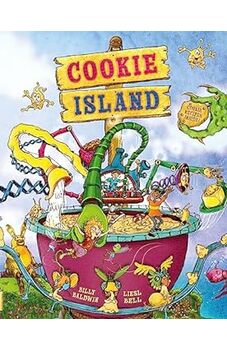
Cookie Island

Paws, Tails and Tales

Raging Currents
Kindle book giveaway.

The 5 Levels of Leadership
Click here to learn about the free offer(s) from this author..

5 Strategies for Improving Mental Health at Work
- Morra Aarons-Mele

Benefits and conversations around mental health evolved during the pandemic. Workplace cultures are starting to catch up.
Companies are investing in — and talking about — mental health more often these days. But employees aren’t reporting a corresponding rise in well-being. Why? The author, who wrote a book on mental health and work last year, explores several key ways organizations haven’t gone far enough in implementing a culture of well-being. She also makes five key suggestions on what they can do to improve the mental health of their employees.
“I have never felt so seen.”
- Morra Aarons-Mele is a workplace mental health consultant and author of The Anxious Achiever: Turn Your Biggest Fears Into Your Leadership Superpower (Harvard Business Review Press, 2023). She has written for The New York Times, The Wall Street Journal, O the Oprah Magazine, TED, among others, and is the host of the Anxious Achiever podcast from LinkedIn Presents. morraam
Partner Center

IMAGES
VIDEO
COMMENTS
I finished reading the book "The 5 Levels of Leadership by John C. Maxwell". Another Favorite of many reads so far, and I have always enjoyed reading books from John C. Maxwell. One of my takeaways was when J.C. Maxwell mentioned in the book about the five levels; how we start from level 1 and what it takes to get to level 5. The 5 Levels
John Maxell's book, The Five Levels of Leadership, is an invaluable resource for organizations, ministries, families, and individuals seeking growth and development. Maxwell's keen insights into the different levels of leadership, how to develop one's self and others in each level, and the poignant personal evaluations for each reader are ...
The Amazon Book Review Book recommendations, author interviews, editors' picks, and more. Read it now. ... John Maxell's book, The Five Levels of Leadership, is an invaluable resource for organizations, ministries, families, and individuals seeking growth and development. Maxwell's keen insights into the different levels of leadership, how ...
The answer, according to bestselling author John C. Maxwell, lies in The 5 Levels of Leadership. Focused on growing one's leadership potential in a tiered manner, the book provides pragmatic steps to scale the leadership ladder while achieving lasting impact on one's organisation and followers.
People follow you because they want to. Level 3: Production . People follow you because of what you have done for the organization. Level 4: People Development. People follow you because of what you have done for them. Level 5: Pinnacle. People follow you because of who you are and what you represent.
Book: The 5 Levels of Leadership by John Maxwell. Reviewer: Bobby Powers. My Thoughts: 8 of 10. John Maxwell is one of my favorite leadership authors. I've read the majority of his books and enjoyed all of them. Of all his work, The 5 Levels does the best job of defining what separates good leaders from great leaders.
The challenge of leadership is to create change and facilitate growth. The 5 levels provide a clear step for growth, John Maxwell noted. Overview of the 5 levels. Level 1: Position: People who ...
John C. Maxwell is a #1 New York Times bestselling author, coach, and speaker who has sold more than twenty-four million books in fifty languages. Often called America's #1 leadership authority, Maxwell was identified as the most popular leadership expert in the world by Inc. magazine in 2014. And he has been voted the top leadership professional six years in a row on LeadershipGurus.net.
Amazon.in - Buy The 5 Levels of Leadership: ... #22,361 in Reference (Books) Customer Reviews: 4.7 4.7 out of 5 stars 4,131 ratings. About the author. Follow authors to get new release updates, plus improved recommendations. John C. Maxwell. Brief content visible, double tap to read full content.
Level 1: Position. Level 2: Permission. Level 3: Production. Level 4: People Development. Level 5: The Pinnacle. Next Steps: Buy the 5 Levels of leadership. The book in this summary, The 5 Levels of Leadership: Proven Steps to Maximize Your Potential, expands on the concept of the five levels from the John Maxwell leadership notes and offers ...
The 5 Levels of Leadership will not only tell you how to climb higher, it will give you the motivation you need to reach the top."-- Dan T. Cathy, President & Chief Operating Officer, Chick-fil-A, Inc. John Maxwell's books have been required reading for my leadership team for years.
The 5 Levels of Leadership. A business executive. A softball coach. A classroom teacher. A volunteer coordinator. A parent. Whether you're one of these things or all of these things, one thing remains true: You are a leader.
Find helpful customer reviews and review ratings for The 5 Levels of Leadership (10th Anniversary Edition): ... John Maxell's book, The Five Levels of Leadership, is an invaluable resource for organizations, ministries, families, and individuals seeking growth and development. Maxwell's keen insights into the different levels of leadership ...
At its core, The 5 Levels of Leadership revolves around 5 "Ps" stacked in ascending order of significance. These are Position , Permission , Production , People Development, and Pinnacle. They are graphically represented by the diagram below: Courtesy of John Maxwell. The first level of Position is achieved when one gets a job with a ...
The true value of the five levels is the outward focus the levels create, always seeking to help grow others and base one's level of success on how well others succeed. It is a book of servant leadership - a counter paradigm to the "dog-eat-dog" world that often characterizes corporate America as well as the private lives of most cultures.
John C. Maxwell is a #1 New York Times bestselling author, coach, and speaker who has sold more than twenty-four million books in fifty languages. Often called America's #1 leadership authority, Maxwell was identified as the most popular leadership expert in the world by Inc. magazine in 2014. And he has been voted the top leadership professional six years in a row on LeadershipGurus.net.
5 Levels of Leadership (2011) by John C. Maxwell is a book that explores the different stages of leadership and offers valuable insights for aspiring leaders. Here's what makes this book worth reading: It provides a practical roadmap for developing leadership skills, with clear steps to progress from one level to another.
The 5 Levels Of Leadership Review. The 5 Levels of Leadership is a really inspiring book. It felt like some of the ideas were things I'd heard before, but I really think there is a lot of power in the basics of good leadership. I'm excited to try to practice these principles myself to really make a difference in people's lives!
The essential ingredient for taking a company to greatness is having a "Level 5" leader, an executive in whom extreme personal humility blends paradoxically with intense professional will. In ...
Maxwell did a good job of narrating his own book and taking the listener first through an overview of the five levels of leadership, which did indeed turn out to be proven steps to maximize your potential. ... This author participates in the Readers' Favorite Book Review Exchange Program, which is open to all authors and is completely free ...
True leadership isn't a matter of having a certain job or title. In fact, being chosen for a position is only the first of the five levels every effective leader achieves. To become more than "the boss" people follow only because they are required to, you have to master the ability to invest in people and inspire them. To grow further in your role, you must achieve results and build a team ...
The 5 Levels of Leadership will not only tell you how to climb higher, it will give you the motivation you need to reach the top."― Dan T. Cathy, President & Chief Operating Officer, Chick-fil-A, Inc. "John has taught THE 5 LEVELS OF LEADERSHIP to our leaders at Delta with great results. The insight and valuable principles he delivers has ...
Experts review Japan's Quiet Leadership and The Neptune Factor. ... Book Reviews. May 2024. Proceedings. Vol. 150/5/1,455. Book Reviews. View Issue. Comments. ... (JSDF) understand its level of commitment, professionalism, and dedication to preserving a peaceful Indo-Pacific. However, the U.S. military can have a tendency to frame bilateral ...
Morra Aarons-Mele is a workplace mental health consultant and author of The Anxious Achiever: Turn Your Biggest Fears Into Your Leadership Superpower (Harvard Business Review Press, 2023). She has ...
The Amazon Book Review Book recommendations, author interviews, editors' picks, and more. Read it now. ... John Maxell's book, The Five Levels of Leadership, is an invaluable resource for organizations, ministries, families, and individuals seeking growth and development. Maxwell's keen insights into the different levels of leadership, how ...
2.1. Definition of organizational culture. OC is a set of norms, values, beliefs, and attitudes that guide the actions of all organization members and have a significant impact on employee behavior (Schein, Citation 1992).Supporting Schein's definition, Denison et al. (Citation 2012) define OC as the underlying values, protocols, beliefs, and assumptions that organizational members hold, and ...